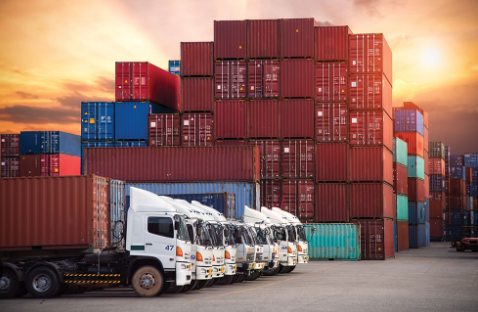Global supply chains are under more pressure than ever before. From rising freight costs to ongoing labour shortages and geopolitical disruptions, businesses are being forced to rethink the way they manage logistics. Traditional systems are no longer sufficient to handle this complexity. Enter digital supply chain platforms,intelligent systems designed to bring visibility, control, and resilience to logistics operations.
Responding to Rising Freight Costs
One of the most pressing challenges in today’s supply chain landscape is the continuous increase in freight costs. Factors like fuel price volatility, driver shortages, and regulatory changes are pushing transportation expenses higher. Digital supply chain platforms allow businesses to take a proactive approach. With automated shipment tendering, companies can match loads to the most cost-effective carriers, avoid inflated spot rates, and optimise routes for fuel efficiency. These platforms also provide insights into cost per shipment, helping finance teams plan and control budgets with greater accuracy.

Labour Shortages and Automation
Warehouses and logistics companies across the globe are facing workforce shortages, affecting fulfilment speed and reliability. Digital tools help fill these gaps by automating repetitive tasks, such as load scheduling, document management, and vehicle assignments. With fewer manual touchpoints, companies can maintain operational continuity even with limited human resources. Automating these workflows also minimises errors and improves turnaround times, ensuring that customers receive their goods on time.
Monitoring Critical KPIs
Keeping an eye on metrics such as time-to-deliver, turnaround time, and on-time delivery is essential for navigating today’s logistics landscape. Digital platforms offer unified dashboards where businesses can monitor these KPIs in real time. They not only track daily performance but also provide historical data, allowing companies to identify patterns and make strategic decisions based on facts, not assumptions.

Building Resilience with Data-Driven Decisions
Perhaps the most valuable benefit of digital logistics platforms is their ability to make supply chains more resilient. By integrating data from multiple sources—transporters, warehouses, and consignees—businesses can predict delays, reroute shipments, and ensure smoother handovers. This flexibility is crucial in a world where unexpected disruptions are the new normal.
Conclusion
Adaptability is no longer a luxury—it’s a requirement. Digital supply chain platforms enable businesses to tackle modern challenges head-on by improving efficiency, lowering costs, and strengthening operations.
Discover how Truck It In can support your transformation. Visit www.truckitin.ai to learn more!
In today’s fast-moving logistics landscape, businesses are under pressure to deliver goods faster, more accurately, and with greater transparency. However, traditional supply chain systems often struggle with fragmented data, lack of visibility, and inefficiencies that directly impact performance. Bridging these gaps demands smarter delivery processes backed by digital solutions.
Delivery Visibility for Better Performance
One of the primary gaps in legacy systems is poor delivery visibility. Businesses often rely on manual updates, resulting in communication breakdowns and missed deadlines. With digital platforms like OpenPod by OpenPort, companies can achieve complete visibility from dispatch to drop-off. These systems offer real-time updates at the SKU level, allowing for faster confirmation of deliveries and immediate reporting of excesses or shortages. The result is a more accurate, transparent delivery process that builds trust and reduces costly disputes.

KPI-Driven Execution
Monitoring key performance indicators such as on-time delivery and turnaround times is vital for continuous improvement. Smart delivery systems allow real-time tracking of these KPIs through integrated dashboards. Businesses can monitor routes, anticipate bottlenecks, and proactively intervene when performance dips below expectations. Over time, this data-driven approach helps streamline operations and improve customer satisfaction.
Smarter Collaboration Across Stakeholders
Misaligned communication between warehouse teams, transporters, and receivers is a major hurdle in delivery management. Smarter systems solve this by consolidating information into one digital interface. Every stakeholder from dispatch to deliver receives automated updates, ensuring everyone is on the same page without relying on manual coordination or multiple communication apps.
Sustainability and Cost Control
Optimising deliveries also helps reduce empty miles and resource wastage, contributing to sustainability goals. Better route planning, capacity utilisation, and digitised documentation all help in reducing the environmental impact and keeping costs under control.

Conclusion
Ensuring safety and compliance in high-stakes supply chains requires a combination of robust data monitoring and proactive management strategies. By leveraging advanced technology, companies can safeguard their operations and maintain a high level of performance.
Explore innovative logistics solutions to optimise every stage of your supply chain. Visit www.truckitin.ai to learn more!
Introduction
Safety and compliance are paramount in managing high-stakes supply chains. With increasing regulatory requirements and the need to protect valuable assets, logistics companies must adopt robust strategies to monitor vehicle and driver data effectively.
The Role of Data in Enhancing Safety
Monitoring vehicle and driver data is crucial for maintaining high safety standards. Data-driven insights help identify potential safety risks, such as driver fatigue, vehicle malfunctions, or unsafe driving practices. By acting on these insights, companies can reduce incident rates and ensure safer logistics operations.
Maintaining Compliance with Industry Standards
Compliance is not just about avoiding fines—it’s about building a culture of safety and reliability. Real-time data tracking enables logistics managers to ensure that all vehicles and drivers meet regulatory requirements. This includes monitoring compliance percentages and taking proactive measures to address any gaps.

Improving Incident Response and Prevention
In case of an incident, having access to detailed vehicle and driver data can expedite response times. Logistics managers can analyse the data to understand what went wrong and implement measures to prevent similar incidents in the future. This proactive approach not only improves compliance rates but also enhances overall safety.
Conclusion
Ensuring safety and compliance in high-stakes supply chains requires a combination of robust data monitoring and proactive management strategies. By leveraging advanced technology, companies can safeguard their operations and maintain a high level of performance.
Explore innovative logistics solutions to optimise every stage of your supply chain. Visit www.truckitin.ai to learn more!
Introduction
In today’s fast-paced logistics environment, supply chains are more volatile than ever. Disruptions such as fluctuating demand, geopolitical tensions, and unpredictable weather conditions can significantly impact logistics operations. Amid these challenges, route optimisation has become a critical strategy to maintain efficiency and keep logistics KPIs on track.

Enhancing Driver Productivity
Effective route management directly influences driver productivity. By optimising routes, companies can minimise idle time, reduce fuel consumption, and ensure that drivers spend more time on productive tasks. Advanced route optimisation tools can also help in assigning the right driver to the right job, further enhancing productivity.
Improving Transit Time
Transit time is a vital KPI in logistics. Optimised routes help reduce travel time, avoid congested areas, and ensure timely deliveries. With real-time insights into traffic conditions and potential roadblocks, logistics managers can adjust routes dynamically to maintain delivery schedules and meet customer expectations.

Addressing Abnormal Stoppages
Abnormal stoppages can disrupt supply chains and increase costs. With route optimisation, logistics teams gain visibility into the exact location and status of shipments. This visibility helps identify and address delays promptly, ensuring that any issues are resolved before they escalate into significant problems.
Conclusion
Route optimisation is not just about finding the shortest path from point A to point B. It is about creating a flexible and resilient supply chain that can withstand volatility and deliver consistent results.
Stay ahead of logistics challenges with Truck It In’s innovative solutions. Learn how to tackle global supply chain problems and optimise your KPIs at www.truckitin.ai.
The Challenge of Capacity Constraints
As global supply chains continue to face unprecedented disruptions, capacity constraints have become one of the most pressing issues for logistics companies. Fluctuating demand, combined with limited transport availability, often leads to delays, higher shipping costs, and underutilised fleets. To navigate this challenge, businesses need a strategic approach to ensure they can access the right transport capacity when and where it’s needed most.
The Power of Competitive Bidding
Market-based bidding platforms offer a dynamic solution to capacity challenges. By allowing transporters to bid on loads in real-time, businesses can tap into a vast pool of available resources and secure the best rates based on current market conditions. This competitive environment not only increases the chances of finding available transport but also drives down costs by encouraging competition among transporters.

Instant Booking for Efficient Operations
Digital platforms that facilitate competitive bidding also enable instant booking, eliminating the delays often associated with traditional booking methods. Once the right transporter has been selected, the system automatically confirms the booking, streamlining the process and ensuring that shipments can proceed without unnecessary holdups. This level of automation reduces administrative overhead and improves overall efficiency in load booking.
Optimising Fleet Utilisation
Market-based bidding ensures that fleet utilisation is maximised by matching shipments with available transporters at optimal cost points. By increasing access to a wider range of transport options, businesses can ensure that vehicles are fully utilised, reducing empty miles and maximising profitability. This also leads to more consistent asset deployment and better management of fleet capacity across different regions and routes.
Reducing Cost-to-Serve KPIs
Competitive bidding platforms help reduce the overall cost-to-serve by securing transport at more competitive prices. The bidding process allows businesses to choose the most cost-effective option for every shipment while maintaining service quality. This approach directly impacts KPIs such as cost per shipment, cost per mile, and overall transport spend, contributing to improved profitability and operational efficiency.

The Future of Transport Procurement
To navigate ongoing capacity constraints, businesses must embrace innovative solutions that enhance flexibility, reduce costs, and improve fleet management. Market-based bidding platforms offer a path forward, helping companies stay competitive in a rapidly changing logistics landscape.
Solve Capacity Challenges with Advanced Solutions
Stay ahead of logistics challenges with Truck It In’s innovative solutions. Learn how to tackle global supply chain problems and optimise your KPIs at www.truckitin.ai .
The Load Booking Dilemma
Global supply chain disruptions have placed immense pressure on logistics operations. Delayed shipments, fluctuating demand, and unpredictable market conditions have made traditional load booking methods increasingly ineffective. Manual sourcing processes, limited transporter options, and a lack of real-time visibility exacerbate these challenges, resulting in unmet KPIs like truck availability rate and cost per mile.
The Role of Digital Platforms
Digital platforms are transforming how businesses approach load booking. By providing a centralised and automated solution, these platforms streamline the transport sourcing process, reducing reliance on time-consuming phone calls and emails. With real-time updates and an expanded pool of pre-approved transporters, businesses can ensure that trucks are available exactly when and where they’re needed.

Simplifying Transport Sourcing
Advanced digital platforms enable shippers to post load requirements, review competitive bids, and confirm bookings instantly. This not only simplifies the sourcing process but also ensures cost efficiency by fostering competition among transporters. By leveraging data-driven tools, businesses can make informed decisions that optimise load allocation and reduce operational costs.

Meeting Critical KPIs
Truck Availability Rate: Digital platforms offer access to an extensive network of transporters, increasing the likelihood of finding the right vehicle for every load. Real-time tracking and automated matching minimise downtime and ensure resources are optimally utilised.
Cost Per Mile: Transparent bidding systems allow businesses to secure the best rates for transport, reducing overall cost per mile without compromising service quality. Historical data and predictive analytics also help identify cost-saving opportunities.
The Path Forward
Amid global supply chain disruptions, embracing digitalisation is no longer optional—it’s essential. By leveraging cutting-edge platforms, businesses can overcome load booking challenges, improve operational resilience, and stay ahead in an unpredictable logistics landscape.
Drive Efficiency with Digital Solutions
Stay ahead of logistics challenges with Truck It In’s innovative solutions. Learn how to tackle global supply chain problems and optimise your KPIs at www.truckitin.ai.
The Cost of Delivery Errors
Delivery errors, whether caused by incorrect documentation, damaged goods, or delayed confirmations, can lead to significant financial losses and strained customer relationships. These challenges highlight the need for robust, real-time proof of delivery (ePOD) systems that address inefficiencies and improve critical KPIs such as on-time acceptance and damage rates.
Real-Time ePOD for Enhanced Accuracy
Immediate ePOD submissions eliminate the risks associated with manual paperwork and delayed reporting. By providing digital proof of delivery, including photos and timestamps, businesses can ensure accurate and timely updates for every shipment. This not only prevents disputes but also builds trust with customers through transparent operations.

Tracking Offloading Efficiency
Delivery performance is not just about getting goods to their destination—it’s also about efficient offloading. Advanced ePOD tools enable businesses to monitor offloading times, assess unloading conditions, and ensure goods are handled properly. This reduces the risk of damage and optimises KPIs such as delivery accuracy and turnaround times.

Resolving Discrepancies with Data Insights
Digital proof of delivery systems allow for SKU-level reporting, providing detailed insights into shortages, damages, or delivery exceptions. This level of granularity enables businesses to resolve discrepancies faster and improve accountability across their supply chain.
Build a Stronger Delivery Network
Combat delivery challenges with real-time proof of delivery solutions that enhance accuracy and customer satisfaction. Stay ahead of logistics challenges with Truck It In’s innovative solutions. Learn how to tackle global supply chain problems and optimise your KPIs at www.truckitin.ai .
The Challenge of Yard Delays
Yard operations are a critical component of the supply chain, yet inefficiencies such as prolonged gate queues, delayed dock assignments and manual tracking processes often lead to increased costs and missed deadlines. These challenges not only disrupt operations but also impact KPIs like dock utilisation and turnaround time, directly influencing overall productivity.

Advanced Tracking for Gate-In and Dock Operations
Smarter yard management begins with tools that track key activities such as Gate-In and Dock-In/Out in real time. These tools provide precise data on vehicle entry, dock allocation, and departure, ensuring smooth transitions between stages. With this level of visibility, businesses can preempt bottlenecks and maintain a steady flow of operations.
Optimising Load Times with Automation
Automation is revolutionising load management by replacing manual processes with real-time monitoring and alerts. Automated systems ensure that vehicles are loaded and unloaded efficiently, minimising idle times and improving dock turnover rates. This efficiency directly impacts KPIs like average dwell time and load accuracy, driving cost savings and improved service levels.

Leveraging Data for Yard Efficiency
Data analytics play a pivotal role in yard management. By analysing patterns and identifying delays, businesses can optimise schedules, improve resource allocation, and enhance overall throughput. Tracking metrics such as average gate wait time and dock assignment speed allows managers to pinpoint inefficiencies and implement corrective actions.
Stay Ahead of Yard Challenges
Embrace the future of yard management with smarter tools designed to optimise every step of your operations. Stay ahead of logistics challenges with Truck It In’s innovative solutions. Learn how to tackle global supply chain problems and optimise your KPIs at www.truckitin.ai.
The Problem with Fragmented Communication
Logistics operations often suffer from siloed systems, where departments work independently, leading to inefficiencies and miscommunication. This fragmentation creates delays, increases costs, and reduces overall service quality, impacting critical metrics like shipment visibility and order fulfilment rates.
Enabling Real-Time Collaboration
Interconnected systems provide a single source of truth for all stakeholders. By integrating communication tools and data-sharing platforms, businesses can break down silos, ensuring that shippers, carriers, and customers are aligned. This approach not only speeds up decision-making but also improves accuracy in every phase of logistics.

Tracking Shipment Visibility
One of the biggest challenges in logistics is maintaining real-time visibility of shipments. Advanced platforms enable continuous tracking, providing updates on location, status, and estimated delivery times. This transparency allows businesses to address delays proactively and enhance customer satisfaction.
Improving Order Fulfilment Rates
Efficient communication and data sharing streamline the order fulfilment process. From warehouse operations to last-mile delivery, interconnected systems ensure that each stage runs smoothly. By reducing bottlenecks, businesses can consistently meet or exceed fulfilment KPIs.
The Way Forward
Breaking down silos requires a commitment to digital transformation and collaboration. By adopting these practices, businesses can optimise their operations, reduce inefficiencies, and drive better outcomes.

Stay Connected with Advanced Solutions Stay ahead of logistics challenges with Truck It In’s innovative solutions. Learn how to tackle global supply chain problems and optimise your KPIs at www.truckitin.ai.
The Rising Cost of Supply Chain Management
Rising freight costs, inefficient operations, and fragmented processes have become significant challenges for businesses striving to maintain profitability. As logistics complexities grow, the need for smarter shipment planning has never been more critical.
Smarter Shipment Tendering
Intelligent shipment tendering automates the process of matching loads with carriers, ensuring the right transport is allocated at optimal costs. By leveraging advanced tools, businesses can reduce reliance on manual processes, which often result in delays and errors. These systems analyse multiple variables such as delivery timelines, vehicle capacity, and route efficiency to make data-driven decisions.

Optimising Load Planning
Inefficient load planning leads to underutilised resources and higher freight expenses. Advanced load planning solutions ensure vehicles are used to their full capacity, reducing empty miles and optimising fleet utilisation. This approach also minimises carbon emissions, addressing both cost and sustainability concerns.
KPI Optimisation: On-Time Delivery and Cost Per Shipment
Reducing supply chain costs hinges on monitoring and optimising critical KPIs. Smarter shipment planning tools help businesses achieve higher on-time delivery rates by accounting for variables like traffic, weather, and route efficiency. Additionally, these solutions offer real-time cost analysis, enabling businesses to stay within budget while delivering exceptional service.
Stay Ahead with Smarter Solutions
Stay ahead of logistics challenges with Truck It In’s innovative solutions. Learn how to tackle global supply chain problems and optimise your KPIs at www.truckitin.ai.